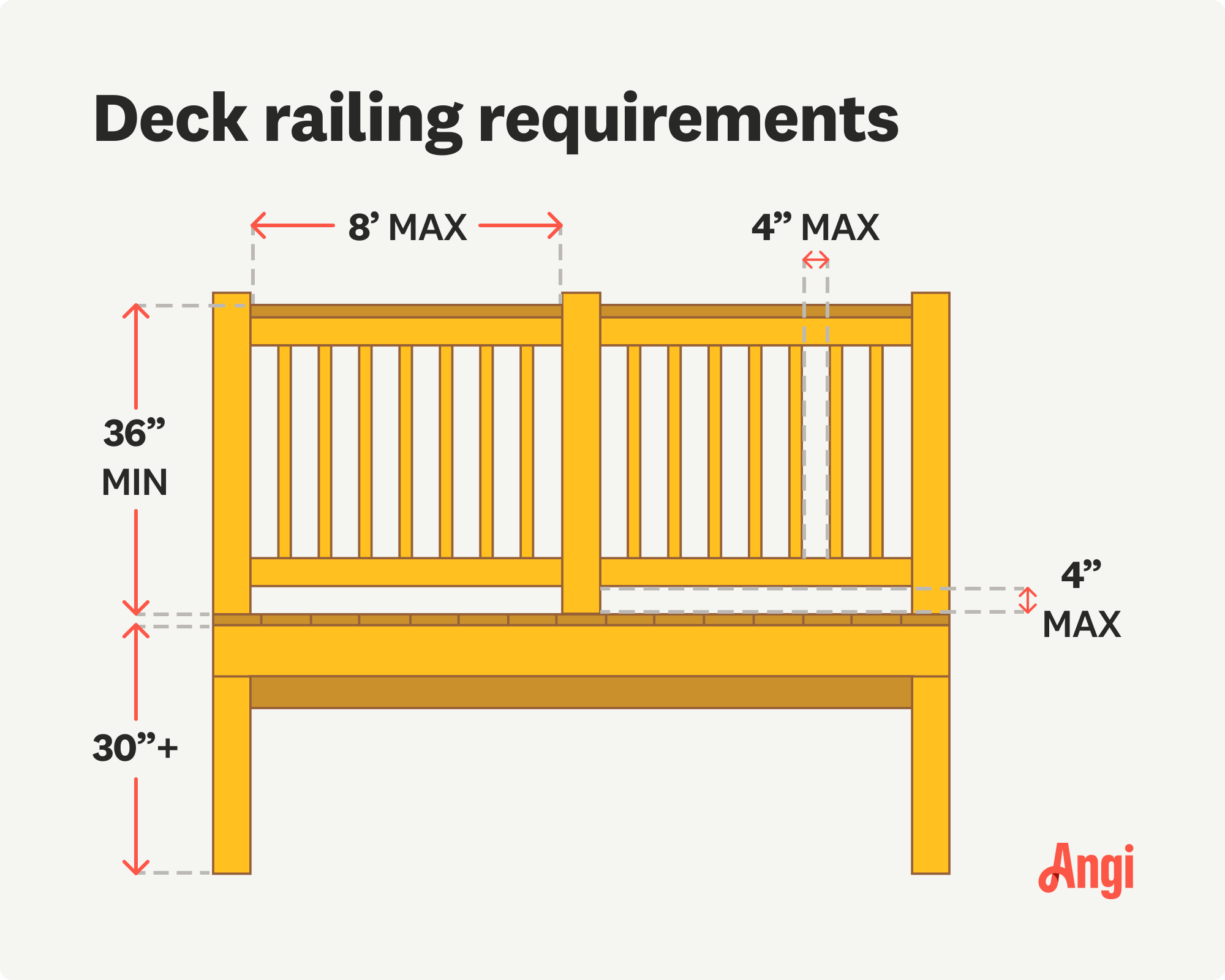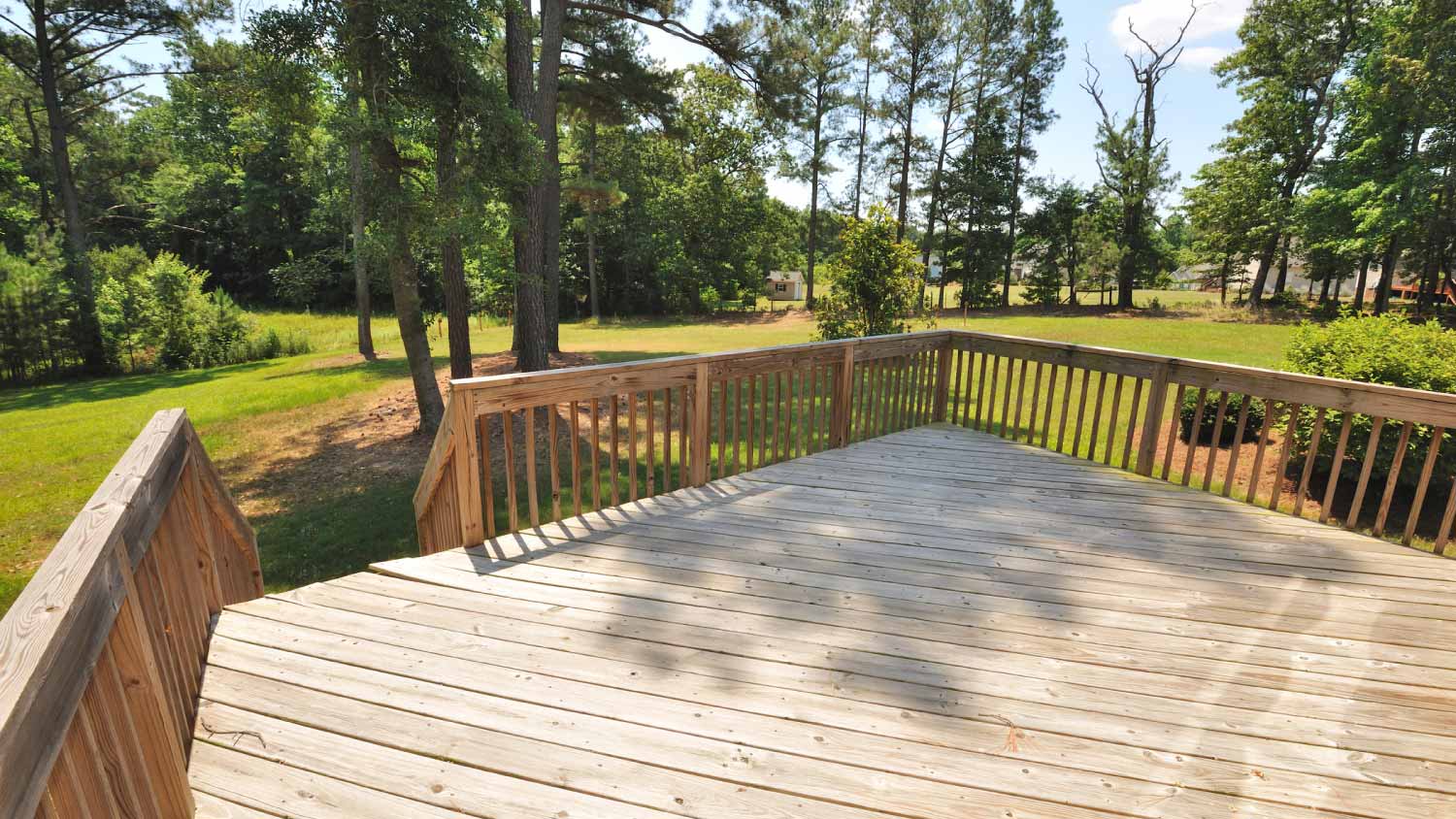When Is a Railing Required on a Deck? Safety Laws You Need to Know
It’s best not to go “off the rails” with this project


If a deck is 30 inches tall or more, you must have a railing.
Railings must be 36 inches tall (minimum), and the space between railing posts must be no more than 8 feet.
There are load requirements for the balusters and top rails on deck railings, too.
Having railings on your deck can increase home value.
Imagine you’re planning your dream deck, or maybe you just finished construction. However, your plans didn’t include railing. This is a good time to start asking, “When is a railing required on a deck?” Deck railings serve multiple purposes, including safety, aesthetics, and compliance with building codes. Let’s explore when you absolutely need a railing, the pros and cons of these features, and more specific requirements to consider when deciding if and when to contact a local deck builder to install railings.
Railing Requirements Based on Deck Height
The height of your deck plays the biggest role in determining if you need a railing. Building codes have specific deck height thresholds for railings. These codes vary by location, but a common rule of thumb is that if your deck is elevated more than 30 inches above the ground, a railing is required.
Check with your local building department or consult your area's building codes to confirm the exact height requirement in your region. Ignoring these requirements can lead to compliance issues and safety hazards (which are the last things you want standing between you and the deck of your dreams).
Other Deck Railing Code Requirements to Keep in Mind
In addition to deck height, there are several other code requirements for installing deck railings to ensure they meet safety standards.

Railing Height Requirements
In most of the United States, deck railings must be a minimum of 36 inches tall from the decking to the top rail, though this varies by location. Notably, California and Washington require railings on decks to be 42 inches or taller.
Load Requirements
Deck railings must be capable of withstanding various loads from a few different angles and origins. These loads include uniform loads, infill loads, and concentrated loads.
The specific load requirements vary, so it's crucial to consult your local building codes or a structural engineer near you to determine the necessary strength for your railings. However, here are the most common guidelines:nd this is
Infill load requirements: A 1-square-foot area on balusters must withstand a force of 125 lbs.
Uniform load requirements: The top rail must endure 125 lbs. of force per foot length applied horizontally or vertically.
Concentrated load requirements: The top rail must support 500 lbs. at a concentrated point at the mid-span, on a post's side, and on top of a post.
Post Spacing
Proper post spacing is essential for the stability and safety of your deck railings. Building codes in your area will specify the maximum allowable distance between railing posts based on the deck material used and the height of the railing. Posts must not be more than 8 feet apart, so follow these guidelines to ensure your railing system is adequately supported.
Baluster Spacing
Balusters are the vertical posts or spindles that run between the top and bottom rails of a railing system. Spacing requirements for balusters are in place to prevent small children from slipping through the gaps. These requirements are crucial if you have young children or pets, so be sure to adhere to the baluster spacing guidelines outlined in your local building codes. Spaces between balusters should be 4 inches or less.
Local Regulation Requirements
Local regulation requirements often vary from city to city, even within the same state. In most cases, you must file a permit alongside any design narrative or drawing plans for approval before you can start building the deck. This process can be stressful and confusing for many unfamiliar with their city’s permitting process and legislative updates. Therefore, it’s best to hire a pro and let them handle the entire process to ensure your new deck is built up to code and legal through each step of the project.
Pros and Cons of Deck Railings

If laws in your area don’t require you to have deck railings, you get to make the decision on your own. Here are some pros and cons of deck railings to consider.
| Pros | Cons |
|---|---|
| Keep people safe | Added cost |
| Enhance visual appeal | Obstruct your view |
| Good ROI | |
| Customizable |
Pros
The primary purpose of deck railings is to keep people safe. Railings prevent accidental falls, making your deck a secure space for family and guests, especially children and pets. The good news is that deck railings can enhance the visual appeal of your deck, and installing deck railings can increase the value of your home. Potential buyers see railings as an added safety feature, making your property more attractive.
There are many types of deck railings in a variety of materials and designs. This allows you to choose a style that complements your home's architecture and your personal taste.
Cons
One of the downsides of installing deck railings is the additional cost on your deck budget. Materials, labor, and maintenance can add to your overall project expenses. Additionally, depending on the design, deck railings can obstruct your view from patio doors and windows. This is a drawback if you have a scenic view you'd like to enjoy.
Types of Deck Railings
Now that you understand the importance of deck railings and the code requirements for this part of your deck, let's explore the different types of deck railings. Each type has its own benefits that can make your deck a comfortable and aesthetic outdoor living space.
Wood Railings
Wood is a classic choice for railings, and it adds a timeless and traditional look to your deck. Wood railings are versatile and can be customized to match your deck's aesthetic, but they require more maintenance over time to protect against rot and decay.
Cable Railings
Cable railings cost a bit more, but they provide a modern and minimalist appearance. They are often made of stainless steel, and they won’t fully obstruct your view, making them an excellent choice for decks with scenic surroundings. Cable railings are durable and low-maintenance.
Glass Railings
Clear glass railings offer an elegant and sophisticated look. They provide an almost completely unobstructed view of your surroundings and allow more natural light to filter through to your deck. Glass railings can be a bit more expensive but are worth considering for their aesthetic appeal.
Aluminum Railings
Known for their durability and resistance to corrosion, aluminum railings are both sturdy and affordable. They come in various styles and colors, making them a versatile choice for different deck designs.
Plexiglass Railings
A budget-friendly alternative to glass, plexiglass railings offer similar transparency and are less prone to shattering. They can be a great compromise between aesthetics and cost and are an even better option than glass in regions that are prone to harsh weather.
How Much Does It Cost to Install a Deck Railing?
Installing a deck railing costs between $10 and $50 per linear foot, with an average cost of $30 per linear foot. Some custom or high-end railings are far more expensive, though. For instance, glass-panel railings and cable railings can cost up to $260 per linear foot. The exact price depends on the type of materials used, the railing style, and the complexity of installation. It also costs more to replace an existing deck railing, as contractors usually charge $10 to $15 per linear foot for railing removal.
DIY vs. Hiring a Pro
Like most home projects, DIY railing installation is cheaper, since it eliminates the cost of labor. All you have to pay for are tools and materials, which might only cost around $150 to $400 when using budget-friendly options like composite, vinyl, and PVC.
However, installing a deck railing requires experience and knowledge of building codes to complete successfully. We recommend most homeowners hire a specialized deck professional or a general contractor. They’ll get the job done quickly and correctly, revamping your deck for years to come.
Frequently Asked Questions
Consider making your deck wheelchair accessible with a wheelchair ramp or a vertical lift. This will ensure those struggling with mobility issues can enjoy the deck as much as the rest of the family members. Making your deck slip-proof for your older family members can significantly enhance their safety level. You can also consider adding sectioned handrails to provide additional support so it’s easier for those living with disabilities to move freely on the deck.
The height of your deck determines whether it needs railings or not. Regulations vary based on where you live, but most local building codes require decks over 30 inches high to have railings. Most areas also require railings to be at least 36 inches high. If your deck or porch is lower than 30 inches, you may be able to build it without railings.
Local building codes don’t list the number of steps a deck can have before it needs a railing. Instead, regulations are based on the height of the deck. In most areas, a deck over 30 inches high must have a railing. That equates to four to seven steps, depending on a deck’s stair height.





- 17 Deck Railing Ideas That Will Elevate Your Hangout Spot
- What’s the Difference Between Cable Railings and Glass Railings?
- What Is the Labor Cost for Installing a New Deck Railing? [2024 Data]
- The Ultimate Deck Safety Checklist for Homeowners
- Deck Step Down: Should My Deck Be Level With My Home?
- Planning for Decking: Everything You Need to Know to Add a Deck to Your Home
- Get Familiar With These 11 Parts of a Deck Before You Start Building
- Top Deck Maintenance Tips for Every Decking Material
- 3 Top Options for Deck Footings Without Digging and When to Use Them
- What Size Deck Can I Build Without a Permit?

 - Derek Rose.png?impolicy=thumbnail)








